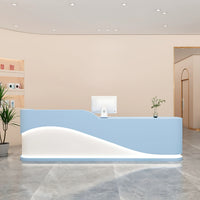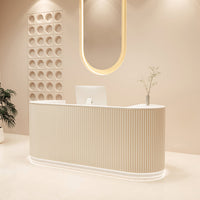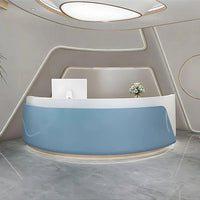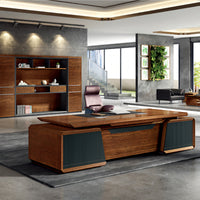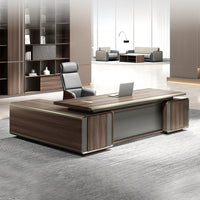What Is the Standard Size of an Executive Desk?
kaguyasuContent Menu
● Understanding Executive Desk Dimensions
>> What Defines an Executive Desk?
>> Standard Executive Desk Dimensions
>>> Height
>>> Width (Left-to-Right Measurement)
>>> Depth (Front-to-Back Measurement)
>>> Summary Table: Common Executive Desk Dimensions
● Types of Executive Desks and Their Sizes
>> Rectangular Executive Desks
>> L-Shaped Executive Desks
>> U-Shaped Executive Desks
>> Comparison Table: Executive Desk Shapes and Sizes
● Executive Desk vs. Standard Office Desk
● Factors to Consider When Choosing Executive Desk Size
>> 1. Office Space
>> 2. Job Requirements
>> 3. Ergonomics
>> 4. Storage Needs
>> 5. Aesthetics and Status
● Customization and Variations
● Tips for Measuring and Fitting Your Executive Desk
● Ergonomics and Health Considerations
● Trends in Executive Desk Design
● Frequently Asked Questions About Executive Desk Sizes
>> 1. What is the most common size for an executive desk?
>> 2. How much space should I leave around my executive desk?
>> 3. Can executive desks be customized for height or width?
>> 4. What materials are commonly used for executive desks?
>> 5. Are L-shaped or U-shaped executive desks better for productivity?
● Additional Questions and Answers
>> 6. What is the difference between an executive desk and a manager desk?
>> 7. How do I choose the right executive desk for a small office?
>> 8. Should I consider a sit-stand executive desk?
>> 9. How do I maintain the finish on a wooden executive desk?
>> 10. Can an executive desk be used in a home office?
● Citations:
When designing or furnishing an executive office, the desk is a centerpiece that reflects authority, status, and professionalism. The size of an executive desk is not just a matter of aesthetics-it directly influences comfort, productivity, and the overall impression of the workspace. In this comprehensive guide, we'll explore the standard sizes of executive desks, factors influencing desk selection, the differences between executive and standard desks, and practical tips for choosing the right desk for your needs.

Understanding Executive Desk Dimensions
What Defines an Executive Desk?
An executive desk is typically larger and more imposing than a standard office desk. It is designed to accommodate the multifaceted responsibilities of senior leaders, providing ample space for paperwork, computers, meetings, and personal items. Executive desks often feature high-quality materials, integrated storage solutions, and a design that projects authority and professionalism.
Standard Executive Desk Dimensions
Height
- The standard height for an executive desk is typically between 28 and 30 inches (71 to 76 cm).
- This height is considered ergonomic for most adults, allowing comfortable arm positioning and proper posture when paired with a standard office chair.
- Some desks offer adjustable heights to cater to individual preferences, but heights rarely exceed 30 inches to maintain practicality.
Width (Left-to-Right Measurement)
- Executive desks usually range from 60 to 72 inches (152 to 183 cm) in width.
- Larger executive desks can even reach up to 90 inches (229 cm) for expansive offices or specialized needs.
- The width provides ample surface area for multiple monitors, documents, and personal items, enabling multitasking and organization.
Depth (Front-to-Back Measurement)
- The standard depth for an executive desk is between 30 and 36 inches (76 to 91 cm).
- This depth ensures enough space for a computer, keyboard, paperwork, and other essential items without feeling cramped.
- Deeper desks are particularly useful for executives who regularly handle large documents or require extra workspace.
Summary Table: Common Executive Desk Dimensions
| Dimension | Standard Range (inches) | Standard Range (cm) |
|---|---|---|
| Height | 28–30 | 71–76 |
| Width | 60–72 | 152–183 |
| Depth | 30–36 | 76–91 |
Types of Executive Desks and Their Sizes
Rectangular Executive Desks
- The most traditional and widely used shape.
- Standard sizes: 60–72 inches wide, 30–36 inches deep, 28–30 inches high.
- Offers a large, uninterrupted workspace suitable for most executive tasks.
L-Shaped Executive Desks
- Designed to maximize corner office space and provide distinct work zones.
- Common sizes: Main section 60–72 inches wide, return section 48–60 inches long, both 30–36 inches deep.
- Ideal for executives who need separate areas for computer work and paperwork or frequent meetings.
U-Shaped Executive Desks
- Feature a central desk with two extended side panels, forming a U-shape.
- Typical dimensions: Central desk 60–72 inches wide, each side panel 48–60 inches long, 30–36 inches deep.
- Provide the most workspace and storage, suitable for high-level executives with extensive responsibilities.
Comparison Table: Executive Desk Shapes and Sizes
| Desk Shape | Width (inches) | Depth (inches) | Height (inches) | Features |
|---|---|---|---|---|
| Rectangular | 60–72 | 30–36 | 28–30 | Classic, versatile, spacious |
| L-Shaped | 60–72 (main) | 30–36 | 28–30 | Corner fit, dual work zones |
| U-Shaped | 60–72 (center) | 30–36 | 28–30 | Maximum workspace, storage |
Executive Desk vs. Standard Office Desk
| Feature | Executive Desk | Standard Office Desk |
|---|---|---|
| Width | 60–72 inches (152–183 cm) | 48–60 inches (122–152 cm) |
| Depth | 30–36 inches (76–91 cm) | 24–30 inches (61–76 cm) |
| Height | 28–30 inches (71–76 cm) | 28–30 inches (71–76 cm) |
| Storage | Extensive, drawers/cabinets | Limited, basic drawers |
| Materials | Premium woods, veneers | Laminates, metal, wood |
| Presence | Imposing, authoritative | Functional, compact |
Factors to Consider When Choosing Executive Desk Size
1. Office Space
- Measure the available floor area, accounting for space behind and in front of the desk for movement and seating.
- Leave at least 3 feet (about 91 cm) behind the desk for a chair and walking space.
2. Job Requirements
- Consider the nature of your work: Do you need space for multiple monitors, frequent meetings, or extensive paperwork?
- Choose a desk with sufficient surface area and storage to support your daily tasks.
3. Ergonomics
- Ensure the desk height allows your arms to rest comfortably at a 90-degree angle while typing.
- The monitor should be at eye level and at least an arm's length away to reduce eye strain.
4. Storage Needs
- Executive desks often include built-in drawers, cabinets, or hutches for organization.
- Assess your storage needs for files, office supplies, and personal items.
5. Aesthetics and Status
- The desk should reflect your role and the company's image, often favoring high-quality materials and finishes.
- Larger, more elaborate desks convey authority and professionalism.
Customization and Variations
While standard sizes suit most executives, customization is common. Taller or shorter individuals may require desks with adjustable heights. Some executives may opt for extra-wide desks or unique shapes to fit specific office layouts or personal preferences. Modular designs allow for flexibility, enabling the addition of returns, hutches, or side tables as needed.
Tips for Measuring and Fitting Your Executive Desk
- Use a tape measure to determine the maximum desk size your office can comfortably accommodate.
- Account for other furniture, such as guest chairs, bookshelves, or filing cabinets.
- Consider the placement of power outlets, windows, and doors when positioning your desk.
- If you frequently host meetings, ensure there is enough space in front of the desk for visitors.
Ergonomics and Health Considerations
A well-sized executive desk should promote good posture and reduce fatigue. Pair your desk with an ergonomic chair, and ensure there is adequate legroom beneath the desk. Adjustable monitor arms, keyboard trays, and footrests can further enhance comfort and productivity.
Trends in Executive Desk Design
Modern executive desks blend functionality with style. Trends include:
- Minimalist designs with clean lines and integrated cable management.
- Sustainable materials, such as reclaimed wood or eco-friendly laminates.
- Sit-stand executive desks that allow for alternating between sitting and standing.
- Smart desks with built-in charging ports, wireless charging pads, and connectivity features.
Frequently Asked Questions About Executive Desk Sizes
1. What is the most common size for an executive desk?
The most common executive desk size is 60 to 72 inches wide, 30 to 36 inches deep, and 28 to 30 inches high. This provides ample workspace and storage for most executive needs.
2. How much space should I leave around my executive desk?
It's recommended to leave at least 3 feet (91 cm) behind the desk for a chair and walking space, and at least 3 feet in front for guest seating or additional furniture.
3. Can executive desks be customized for height or width?
Yes, many manufacturers offer custom options for desk height, width, and depth to accommodate individual preferences, ergonomic needs, and unique office layouts.
4. What materials are commonly used for executive desks?
Executive desks are often made from premium materials such as solid wood, wood veneer, metal, and glass. High-quality finishes and craftsmanship are typical to reflect the status of the user.
5. Are L-shaped or U-shaped executive desks better for productivity?
Both L-shaped and U-shaped desks offer increased workspace and organization. L-shaped desks are ideal for maximizing corner space, while U-shaped desks provide the most surface area and storage, making them suitable for executives with extensive responsibilities.
---
Additional Questions and Answers
6. What is the difference between an executive desk and a manager desk?
An executive desk is generally larger, more luxurious, and designed to project authority, while a manager desk is typically smaller and more functional, focusing on practicality rather than status.
7. How do I choose the right executive desk for a small office?
Opt for a rectangular or compact L-shaped desk with integrated storage to maximize workspace without overwhelming the room. Measure carefully and prioritize essential features.
8. Should I consider a sit-stand executive desk?
Sit-stand executive desks offer health benefits by allowing you to alternate between sitting and standing. They are a good choice if you value flexibility and ergonomic health.
9. How do I maintain the finish on a wooden executive desk?
Regularly dust the surface, use coasters for drinks, and avoid placing hot items directly on the desk. Periodically apply wood polish or conditioner to maintain its appearance.
10. Can an executive desk be used in a home office?
Absolutely. If your home office has sufficient space, an executive desk can enhance both functionality and aesthetics, providing a professional environment for remote work.

---
Citations:
[1] https://www.okamura.com.vn/post/size-of-an-executive-desk
[2] https://aceofficesystems.com/blogs/news/office-desk-size-guide
[3] https://www.fezibo.com/blogs/news/standard-desk-dimensions-for-office-desks-and-standing-desks
[4] https://offisavvy.com/what-are-good-desk-dimensions/
[5] https://boulies.com/blogs/tips-and-guides/standard-desk-dimensions-guide-for-home-and-office
[6] https://www.fezibo.com/products/executive-a
[7] https://www.autonomous.ai/ourblog/standard-desk-dimensions-guide
[8] https://www.knoll.com/shop/en_us/home-office-desks-tables/florence-knoll-executive-desk/8578.html
[9] https://www.branchfurniture.com/blogs/turn-key/standard-desk-size
[10] https://www.designcraft.ae/executive-desk-size-chart/
[11] https://tommybahamafurniture.com/admiralty-executive-desk
[12] https://www.uline.com/BL_4285/Downtown-Executive-Office-Desks
[13] https://www.migefurniture.com/product/executive-office-desk-2/
[14] https://www.dimensions.com/collection/desks-work-tables
[15] https://www.nationalbusinessfurniture.com/carbon-steel-executive-desk-72w-x-30d-58141
[16] https://madisonliquidators.com/executive-desk/
---
Hot Tags: China, Global, OEM, private label, manufacturers, factory, suppliers, manufacturing company
